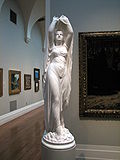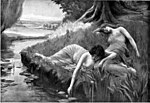Joan the Wad is a mythological character in Cornish folklore. She is the Queen of the Pixies, which are tiny mythical creatures usually associated with...
3 KB (317 words) - 00:49, 24 March 2024
Look up wad or WAD in Wiktionary, the free dictionary. WAD, Wad, or wad may refer to: Joan the Wad, a mythological character in Cornish folklore Nishigandha...
1 KB (211 words) - 01:17, 25 February 2024
Jack-o'-lantern (redirect from Jack the pumpkin)
recorded the use of the term in a rhyme used in Polperro, Cornwall, in conjunction with Joan the Wad, the Cornish version of Will-o'-the-wisp. The people...
22 KB (2,500 words) - 13:13, 17 June 2024
it can be cured by turning a coat inside-out. The queen of the Cornish pixies is said to be Joan the Wad (torch), and she is considered to bless people...
17 KB (2,245 words) - 09:37, 16 July 2024
one of the five ways to overcome the attacks of incubi. The others are Confession, the Sign of the Cross or recital of the Hail Mary, moving the afflicted...
15 KB (1,787 words) - 23:40, 26 August 2024
entity. The word sprite is derived from the Latin spiritus ("spirit"), via the French esprit. Variations on the term include spright and the Celtic spriggan...
4 KB (322 words) - 14:21, 30 April 2024
Fairy Queen (redirect from Queen of the Fairies)
Janet's Foss in the Yorkshire Dales, was romanticized as a fairy queen by non-local writers and poets. Joan the Wad was a Cornish queen of the piskeys, made...
17 KB (2,086 words) - 15:52, 24 May 2024
A bugbear is a legendary creature or type of hobgoblin comparable to the boogeyman (or bugaboo or babau or cucuy), and other creatures of folklore, all...
3 KB (345 words) - 16:40, 2 November 2023
it "the nastiest" of all the demons of Scotland's Northern Isles. The nuckelavee's breath was thought to wilt crops and sicken livestock, and the creature...
17 KB (1,808 words) - 06:25, 14 July 2024
by the famous Danish author Hans Christian Andersen. It was first published by C. A. Reitzel on 16 December 1835 in Copenhagen, Denmark, with "The Naughty...
14 KB (1,413 words) - 19:07, 20 August 2024
Imp (category Wikipedia articles incorporating a citation from the 1911 Encyclopaedia Britannica with Wikisource reference)
demon, frequently described in folklore and superstition. The word may perhaps derive from the term ympe, used to denote a young grafted tree. Imps are...
7 KB (880 words) - 16:04, 25 August 2024
are divided into the Seelie Court and the Unseelie Court. D. L. Ashliman notes that this may be the most famous division of fairies. The Seelie Court is...
8 KB (900 words) - 19:11, 18 July 2024
(dwelling near the Sun / in the heavenly waters) which watches over the Soma (apparently) for the benefit of the gods and the sacrificers." The gandharva also...
11 KB (1,215 words) - 18:19, 2 July 2024
Banshee (redirect from The banshee)
síde [bʲen ˈʃiːðʲe], "woman of the fairy mound" or "fairy woman") is a female spirit in Irish folklore who heralds the death of a family member, usually...
15 KB (1,755 words) - 10:27, 8 April 2024
helpful, but which since the spread of Christianity has often been considered mischievous.(p320) Shakespeare identifies the character of Puck in his A...
13 KB (1,378 words) - 13:27, 17 August 2024
The Headless Horseman is an archetype of mythical figure that has appeared in folklore around Europe since the Middle Ages. The figures are traditionally...
19 KB (2,108 words) - 14:58, 24 August 2024
George Bell and Sons. p. 1413. Pagel, Walter; Rosenberg, Charles (2007). Joan Baptista Van Helmont: Reformer of Science and Medicine. Cambridge University...
16 KB (2,059 words) - 16:02, 15 June 2024
Danish fairy tales The Elf Mound, The Goblin and the Grocer, and The Goblin and the Woman. Goblins are featured in the Norwegian folktale The Christmas Visitors...
17 KB (1,759 words) - 04:58, 17 July 2024
Tuatha Dé Danann (section The Four Treasures)
The Tuatha Dé Danann (Irish: [ˈt̪ˠuə(hə) dʲeː ˈd̪ˠan̪ˠən̪ˠ], meaning "the folk of the goddess Danu"), also known by the earlier name Tuath Dé ("tribe...
20 KB (2,617 words) - 07:09, 9 August 2024
Cat-sìth (section The King of the Cats)
with a white spot on its chest. Legend has it that the spectral cat haunts the Scottish Highlands. The legends surrounding this creature are more common...
7 KB (694 words) - 07:22, 15 May 2024
as the Meliae (ash tree nymphs), the Dryads (oak tree nymphs), the Alseids (grove nymphs), the Naiads (spring nymphs), the Nereids (sea nymphs), the Oceanids...
44 KB (2,068 words) - 23:33, 25 August 2024
Spriggan is a dialect word, pronounced with the grapheme <gg> as /d͡ʒ/, sprid-jan, and not sprigg-an, borrowed from the Cornish plural spyrysyon 'spirits'. Spriggans...
6 KB (724 words) - 22:39, 30 July 2024
occult and alchemical works from around the time of the European Renaissance, and particularly elaborated in the 16th century works of Paracelsus. According...
15 KB (1,840 words) - 10:00, 26 July 2024
The Lady of the Lake (French: Dame du Lac, Demoiselle du Lac, Welsh: Arglwyddes y Llyn, Cornish: Arloedhes an Lynn, Breton: Itron al Lenn, Italian: Dama...
82 KB (10,071 words) - 22:33, 5 August 2024
Tooth fairy (redirect from The toothfairy)
The tooth fairy is a folkloric figure of early childhood in Western and Western-influenced cultures. The folklore states that when children lose one of...
20 KB (2,311 words) - 14:02, 1 August 2024
Her name suggests that she is originally the same being as the völva divine figure Huld and the German Holda. The word hulder is only used of a female; a...
6 KB (666 words) - 01:13, 22 May 2024
appearing in the form of seely wights or The Seelie Court. The Northern and Middle English word seely (also seily, seelie, sealy), and the Scots form seilie...
8 KB (829 words) - 07:12, 19 June 2024
The redcap (or powrie) is a type of malevolent, murderous goblin found in Border folklore. He is said to inhabit ruined castles along the Anglo-Scottish...
7 KB (895 words) - 16:53, 17 March 2024
Irish books use the spelling lioprachán. The first recorded instance of the word in the English language was in Dekker's comedy The Honest Whore, Part...
28 KB (3,123 words) - 00:29, 31 July 2024























